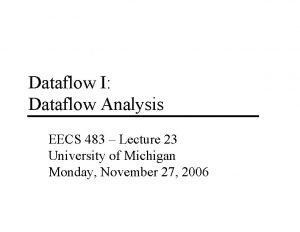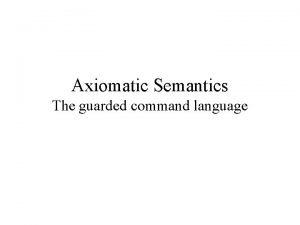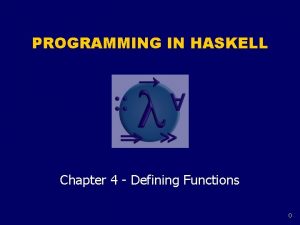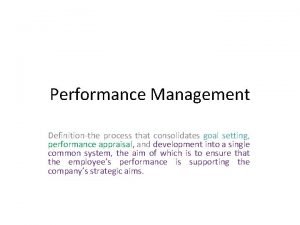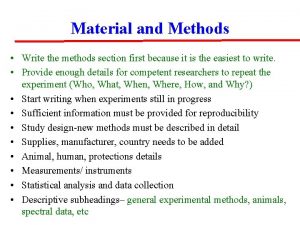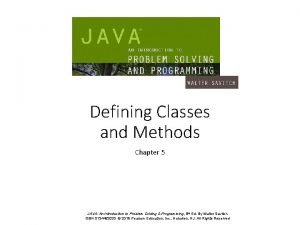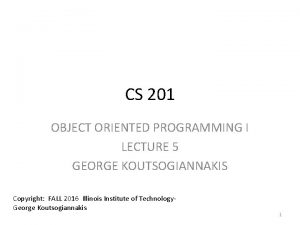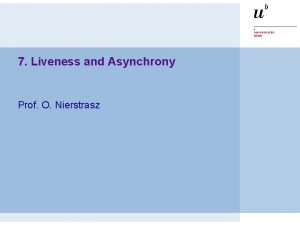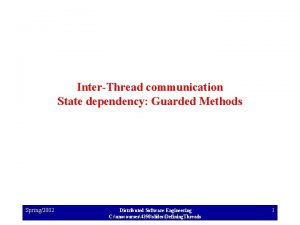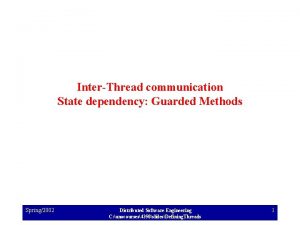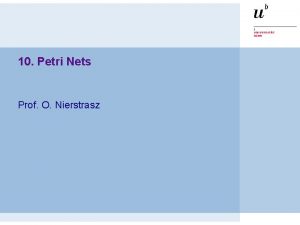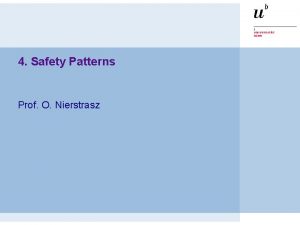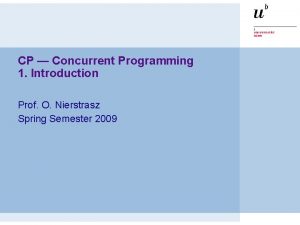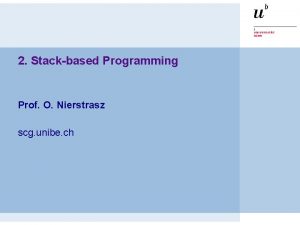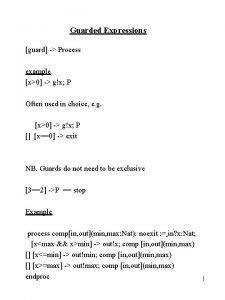5 Liveness and Guarded Methods Prof O Nierstrasz


















































- Slides: 50

5. Liveness and Guarded Methods Prof. O. Nierstrasz Selected material © Magee and Kramer

Liveness and Guarded Methods Roadmap > Liveness — Progress Properties > Deadlock — The Dining Philosophers problem — Detecting and avoiding deadlock > Guarded Methods — Checking guard conditions — Handling interrupts — Structuring notification © Oscar Nierstrasz 2

Liveness and Guarded Methods Roadmap > Liveness — Progress Properties > Deadlock — The Dining Philosophers problem — Detecting and avoiding deadlock > Guarded Methods — Checking guard conditions — Handling interrupts — Structuring notification © Oscar Nierstrasz 3

Liveness and Guarded Methods Liveness > A liveness property asserts that something good eventually happens > A progress property asserts that it is always the case that an action is eventually executed > Progress is the opposite of starvation, the name given to a concurrent programming situation in which an action is never executed © Oscar Nierstrasz 4

Liveness and Guarded Methods Liveness Problems A program may be “safe”, yet suffer from various kinds of liveness problems: Starvation: (AKA “indefinite postponement”) > The system as a whole makes progress, but some individual processes don’t Dormancy: > A waiting process fails to be woken up Premature termination: > A process is killed before it should be Deadlock: > Two or more processes are blocked, each waiting for resources held by another © Oscar Nierstrasz 5

Liveness and Guarded Methods Progress properties — fair choice Fair Choice: If a choice over a set of transitions is executed infinitely often, then every transition in the set will be executed infinitely often. If a coin were tossed an infinite number of times, we would expect that both heads and tails would each be chosen infinitely often. This assumes fair choice ! © Oscar Nierstrasz COIN = ( toss -> heads -> COIN | toss -> tails -> COIN ). 6

Liveness and Guarded Methods Safety vs. Liveness Consider: property SAFE = ( heads -> SAFE | tails -> SAFE ). The safety properties of COIN are not very interesting. How do we express what must happen? © Oscar Nierstrasz 7

Liveness and Guarded Methods Progress properties progress P = {a 1, a 2. . an} asserts that in an infinite execution of a target system, at least one of the actions a 1, a 2. . . an will be executed infinitely often. progress HEADS = {heads} progress TAILS = {tails} No progress violations detected. 0 © Oscar Nierstrasz 1 8

Liveness and Guarded Methods Progress properties Suppose we have both a normal coin and a trick coin TWOCOIN TRICK COIN = ( pick->COIN | pick->TRICK ), = ( toss->heads->COIN | toss->tails->COIN ). Terminal sets © Oscar Nierstrasz 9

Liveness and Guarded Methods Progress analysis A terminal set of states is one in which every state is mutually reachable but no transitions leads out of the set. The terminal set {1, 2} violates progress property TAILS progress HEADS = {heads} progress TAILS = {tails} progress HEADSor. TAILS = {heads, tails} Progress violation: TAILS Trace to terminal set of states: pick Actions in terminal set: {toss, heads} 0 © Oscar Nierstrasz 1 10

Liveness and Guarded Methods Safety vs. Liveness Consider: property REPICK = ( pick -> toss -> REPICK ). Trace to property violation in REPICK: pick toss heads toss How does this safety property expose the flaw in the system? How would you fix the TWOCOIN to have this property pass? 0 © Oscar Nierstrasz 1 11

Liveness and Guarded Methods Roadmap > Liveness — Progress Properties > Deadlock — The Dining Philosophers problem — Detecting and avoiding deadlock > Guarded Methods — Checking guard conditions — Handling interrupts — Structuring notification © Oscar Nierstrasz 12

Liveness and Guarded Methods Deadlock Four necessary and sufficient conditions for deadlock: 1. Serially reusable resources: — the deadlocked processes share resources under mutual exclusion. 2. Incremental acquisition: — processes hold on to acquired resources while waiting to obtain additional ones. 3. No pre-emption: — once acquired by a process, resources cannot be pre-empted but only released voluntarily. 4. Wait-for cycle: 1. a cycle of processes exists in which each process holds a resource which its successor in the cycle is waiting to acquire. © Oscar Nierstrasz 13

Liveness and Guarded Methods Waits-for cycle Has A awaits B A Has E awaits A Has B awaits C E B D Has D awaits E © Oscar Nierstrasz C Has C awaits D 14

Liveness and Guarded Methods Deadlock analysis - primitive processes A deadlocked state is one with no outgoing transitions In FSP: STOP process MOVE = ( north -> ( south -> MOVE | north -> STOP ) ). Progress violation for actions: {north, south} Trace to terminal set of states: north Actions in terminal set: {} 0 © Oscar Nierstrasz 1 15

Liveness and Guarded Methods The Dining Philosophers Problem > Philosophers alternate > > between thinking and eating. A philosopher needs two forks to eat. No two philosophers may hold the same fork simultaneously. There must be no deadlock and no starvation. Want efficient behaviour under absence of contention. © Oscar Nierstrasz 16

Liveness and Guarded Methods Deadlocked diners > A deadlock occurs if a waits-for cycle arises in which each philosopher grabs one fork and waits for the other. © Oscar Nierstrasz 17

Liveness and Guarded Methods Dining Philosophers, Safety and Liveness Dining Philosophers illustrate many classical safety and liveness issues: Mutual Exclusion Condition synchronization Each fork can be used by one philosopher at a time A philosopher needs two forks to eat Shared variable communication Philosophers share forks. . . Message-based communication. . . or they can pass forks to each other Busy-waiting Blocked waiting A philosopher can poll forks. . . or can sleep till woken by a neighbour Livelock All philosophers can grab the left fork and busy-wait for the right. . . Deadlock . . . or grab the left one and wait (sleep) for the right Starvation A philosopher may starve if the left and right neighbours are always faster at grabbing the forks Race conditions © Oscar Nierstrasz Anomalous behaviour depends on timing 18

Liveness and Guarded Methods Modeling Dining Philosophers PHIL = ( -> -> -> sitdown right. get -> left. get eat -> left. put -> right. put arise -> PHIL ). FORK = ( get -> put -> FORK). ||DINERS(N=5)= forall [i: 0. . N-1] ( phil[i]: PHIL || {phil[i]. left, phil[((i-1)+N)%N]. right}: : FORK ). Is this system safe? Is it live? 0 © Oscar Nierstrasz 1 19

Liveness and Guarded Methods Dining Philosophers Analysis Trace to terminal set of states: phil. 0. sitdown phil. 0. right. get phil. 1. sitdown phil. 1. right. get phil. 2. sitdown phil. 2. right. get phil. 3. sitdown phil. 3. right. get phil. 4. sitdown phil. 4. right. get Actions in terminal set: {} © Oscar Nierstrasz No further progress is possible due to the waits-for cycle 20

Liveness and Guarded Methods Eliminating Deadlock There are two fundamentally different approaches to eliminating deadlock. Deadlock detection: > Repeatedly check for waits-for cycles. When detected, choose a victim and force it to release its resources. — Common in transactional systems; the victim should “roll-back” and try again Deadlock avoidance: > Design the system so that a waits-for cycle cannot possibly arise. © Oscar Nierstrasz 21

Liveness and Guarded Methods Dining Philosopher Solutions There are many solutions offering varying degrees of liveness guarantees: Break the cycle > Number the forks. Philosophers grab the lowest numbered fork first. > One philosopher grabs forks in the reverse order. Philosophers queue to sit down > allow no more than four at a time to sit down Do these solutions avoid deadlock? What about starvation? Are they “fair”? © Oscar Nierstrasz 0 1 22

Liveness and Guarded Methods Roadmap > Liveness — Progress Properties > Deadlock — The Dining Philosophers problem — Detecting and avoiding deadlock > Guarded Methods — Checking guard conditions — Handling interrupts — Structuring notification © Oscar Nierstrasz 23

Liveness and Guarded Methods Achieving Liveness There are various strategies and techniques to ensure liveness: > Start with safe design and selectively remove synchronization > Start with live design and selectively add safety > Adopt design patterns that limit the need for synchronization > Adopt standard architectures that avoid cyclic dependencies © Oscar Nierstrasz 24

Liveness and Guarded Methods Pattern: Guarded Methods Intent: Temporarily suspend an incoming thread when an object is not in the right state to fulfil a request, and wait for the state to change rather than balking (raising an exception). © Oscar Nierstrasz 25

Liveness and Guarded Methods — applicability > Clients can tolerate indefinite postponement. (Otherwise, use a balking design. ) > You can guarantee that the required states are eventually reached (via other requests), or if not, that it is acceptable to block forever. > You can arrange that notifications occur after all relevant state changes. (Otherwise consider a design based on a busy-wait spin loop. ) > … © Oscar Nierstrasz 26

Liveness and Guarded Methods — applicability … … > You can avoid or cope with liveness problems due to waiting threads retaining all synchronization locks. > You can construct computable predicates describing the state in which actions will succeed. (Otherwise consider an optimistic design. ) > Conditions and actions are managed within a single object. (Otherwise consider a transactional form. ) © Oscar Nierstrasz 27

Liveness and Guarded Methods — design steps The basic recipe is to use wait in a conditional loop to block until it is safe to proceed, and use notify. All to wake up blocked threads. public synchronized Object service() { while (wrong State) { try { wait(); } catch (Interrupted. Exception e) { } } // fill request and change state. . . notify. All(); return result; } © Oscar Nierstrasz 28

Liveness and Guarded Methods Step: Separate interface from policy Define interfaces for the methods, so that classes can implement guarded methods according to different policies. public interface Bounded. Counter { public static final long MIN = 0; // min value public static final long MAX = 10; // max value public long value(); // inv’t: MIN <= value() <= MAX // init: value() == MIN public void inc(); // pre: value() < MAX public void dec(); // pre: value() > MIN } Counter © Oscar Nierstrasz 29

Liveness and Guarded Methods Step: Check guard conditions > Define a predicate that precisely describes the conditions under which actions may proceed. (This can be encapsulated as a helper method. ) > Precede the conditional actions with a guarded wait loop of the form: while (!condition) { try { wait(); } catch (Interrupted. Exception ex) {. . . } } > Optionally, encapsulate this code as a helper method. © Oscar Nierstrasz 30

Liveness and Guarded Methods Step: Check guard conditions. . . > If there is only one possible condition to check in this class (and all plausible subclasses), and notifications are issued only when the condition is true, then there is no need to re-check the condition after returning from wait() > Ensure that the object is in a consistent state (i. e. , the class invariant holds) before entering any wait (since wait releases the synchronization lock). — The easiest way to do this is to perform the guards before taking any actions. © Oscar Nierstrasz 31

Liveness and Guarded Methods Step: Handle interrupts > Establish a policy to deal with Interrupted. Exceptions. Possibilities include: : — Ignore interrupts (i. e. , an empty catch clause), which preserves safety at the possible expense of liveness. — Terminate the current thread (stop). This preserves safety, though brutally! (Not recommended. ) — Exit the method, possibly raising an exception. This preserves liveness but may require the caller to take special action to preserve safety. — Cleanup and restart. — Ask for user intervention before proceeding. Interrupts can be useful to signal that the guard can never become true because, for example, the collaborating threads have terminated. © Oscar Nierstrasz 32

Liveness and Guarded Methods Step: Signal state changes > Add notification code to each method of the class that changes state in any way that can affect the value of a guard condition. Some options are: — use notify. All to wake up all threads that are blocked in waits for the host object. — use notify to wake up only one thread (if any exist). This is best treated as an optimization where: – all blocked threads are necessarily waiting for conditions signalled by the same notifications, – only one of them can be enabled by any given notification, and – it does not matter which one of them becomes enabled. — You build your own special-purpose notification methods using notify and notify. All. (For example, to selectively notify threads, or to provide certain fairness guarantees. ) © Oscar Nierstrasz 33

Liveness and Guarded Methods Testing for safety violations public abstract class Bounded. Counter. Abstract implements Bounded. Counter { protected long count = MIN; private int errors = 0; } protected void check. Invariant() { if (! (count >= Bounded. Counter. MIN && count <= Bounded. Counter. MAX) ) { errors++; } } Common behaviour public int errors() { to help us test for return errors; } safety violations Counter © Oscar Nierstrasz 34

Liveness and Guarded Methods Basic synchronization public class Bounded. Counter. Basic extends Bounded. Counter. Abstract {. . . public synchronized void inc() { while (count >= MAX) { try { wait(); } catch(Interrupted. Exception ex) { }; } count ++; notify. All(); check. Invariant(); // record safety violations }. . . } © Oscar Nierstrasz 35

Liveness and Guarded Methods Race conditions public class Bounded. Counter. No. Sync. BAD extends Bounded. Counter. Abstract { public void inc() { // missing synchronization while (count >= MAX) { Thread. yield(); } Thread. yield(); // race condition here count ++; check. Invariant(); // possible safety violation } } NB: wait() and notify() are invalid outside synchronized code! © Oscar Nierstrasz 36

Liveness and Guarded Methods notify() vs. notify. All() Careless use of notify() may lead to race conditions. A B BC dec C wait dec wait inc notify wait © Oscar Nierstrasz Now both A and C wait for nothing! 37

Liveness and Guarded Methods Step: Structure notifications Ensure that each wait is balanced by at least one notification. Options include: Blanket Notifications Place a notification at the end of every method that can cause any state change (i. e. , assigns any instance variable). Simple and reliable, but may cause performance problems. . . Encapsulating Assignment Encapsulate assignment to each variable mentioned in any guard condition in a helper method that performs the notification after updating the variable. Tracking State Only issue notifications for the particular state changes that could actually unblock waiting threads. May improve performance, at the cost of flexibility (i. e. , subclassing becomes harder. ) Tracking State Variables Maintain an instance variable that represents control state. Whenever the object changes state, invoke a helper method that reevaluates the control state and will issue notifications if guard conditions are affected. Delegating Notifications © Oscar Nierstrasz Use helper objects to maintain aspects of state and have these helpers issue the notifications. 38

Liveness and Guarded Methods Encapsulating assignment Guards and assignments are encapsulated in helper methods: public class Bounded. Counter. Encapsulated. Assigns extends Bounded. Counter. Abstract {. . . public synchronized void inc() { await. Incrementable(); set. Count(count + 1); } public synchronized void dec() { await. Decrementable(); set. Count(count - 1); }. . . © Oscar Nierstrasz 39

Liveness and Guarded Methods . . . protected synchronized void await. Incrementable() { while (count >= MAX) try { wait(); } catch(Interrupted. Exception ex) {}; } protected synchronized void await. Decrementable() { while (count <= MIN) try { wait(); } catch(Interrupted. Exception ex) { }; } protected synchronized void set. Count(long new. Value) { count = new. Value; notify. All(); } } © Oscar Nierstrasz 40

Liveness and Guarded Methods Tracking State The only transitions that can possibly affect waiting threads are those that step away from logical states top and bottom: public class Bounded. Counter. Tracking. State extends Bounded. Counter. Abstract {. . . public synchronized void inc() { while (count == MAX) try { wait(); } catch(Interrupted. Exception ex) {}; if (count++ == MIN) notify. All(); // just left bottom state }. . . } © Oscar Nierstrasz 41

Liveness and Guarded Methods Tracking State Variables public class Bounded. Counter. State. Variables extends Bounded. Counter. Abstract { protected enum State { BOTTOM, MIDDLE, TOP }; protected State state = State. BOTTOM; public synchronized void inc() { while (state == State. TOP) {// consult logical state try { wait(); } catch(Interrupted. Exception ex) {}; } ++count; // modify actual state check. State(); // sync logical state }. . . © Oscar Nierstrasz 42

Liveness and Guarded Methods . . . protected synchronized void check. State() { State old. State = state; if (count == MIN) { state = State. BOTTOM; } else if (count == MAX) { state = State. TOP; } else { state = State. MIDDLE; } if (left. Old. State(old. State)) { notify. All(); } } private boolean left. Old. State(State old. State) { return state != old. State && (old. State == State. TOP || old. State == State. BOTTOM); } } © Oscar Nierstrasz 43

Liveness and Guarded Methods Delegating notifications public class Notifying. Long { private long value; private Object observer; public Notifying. Long(Object o, long v) { observer = o; value = v; } public synchronized long value() { return value; } public void set. Value(long v) { synchronized(this) { // NB: partial synchronization value = v; } synchronized(observer) { observer. notify. All(); // NB: must be synchronized! } } } © Oscar Nierstrasz 44

Liveness and Guarded Methods Delegating notifications. . . Notification is delegated to the helper object: public class Bounded. Counter. Notifying. Long implements Bounded. Counter { private Notifying. Long count = new Notifying. Long(this, MIN); public synchronized long value() { return count. value(); } public synchronized void inc() { while (count. value() >= MAX) { try { wait(); } catch(Interrupted. Exception ex) {}; } count. set. Value(count. value()+1); // issues notification }. . . } © Oscar Nierstrasz 45

Liveness and Guarded Methods What you should know! > What kinds of liveness problems can occur in concurrent > > > programs? Why is progress a liveness rather than a safety issue? What is fair choice? Why do we need it? What is a terminal set of states? What are necessary and sufficient conditions for deadlock? How can you detect deadlock? How can you avoid it? © Oscar Nierstrasz 46

Liveness and Guarded Methods Can you answer these questions? > How would you manually check a progress property? > What is the difference between starvation and deadlock? > How would you manually detect a waits-for cycle? > What is fairness? © Oscar Nierstrasz 47

Liveness and Guarded Methods What you should know! > When can you apply the Guarded Methods pattern? > When should methods recheck guard conditions after > > > waking from a wait()? Why should you usually prefer notify. All() to notify()? When and where should you issue notification? Why must you re-establish the class invariant before calling wait()? What should you do when you receive an Interrupted. Exception? What is the difference between tracking state and using state-tracking variables? © Oscar Nierstrasz 48

Liveness and Guarded Methods Can you answer these questions? > When are guarded methods better than balking? > When should you use helper methods to implement guarded methods? > What is the best way to structure guarded methods for a class if you would like it to be easy for others to define correctly functioning subclasses? > When is the complexity of delegating notifications worthwhile? © Oscar Nierstrasz 49

Liveness and Guarded Methods License http: //creativecommons. org/licenses/by-sa/2. 5/ Attribution-Share. Alike 2. 5 You are free: • to copy, distribute, display, and perform the work • to make derivative works • to make commercial use of the work Under the following conditions: Attribution. You must attribute the work in the manner specified by the author or licensor. Share Alike. If you alter, transform, or build upon this work, you may distribute the resulting work only under a license identical to this one. • For any reuse or distribution, you must make clear to others the license terms of this work. • Any of these conditions can be waived if you get permission from the copyright holder. Your fair use and other rights are in no way affected by the above. © Oscar Nierstrasz 50
 Oscar nierstrasz
Oscar nierstrasz Safety and liveness in concurrency
Safety and liveness in concurrency Safety liveness
Safety liveness Eecs 483
Eecs 483 Liveness detection
Liveness detection Safety liveness
Safety liveness Guarded lumbar puncture
Guarded lumbar puncture Guarded command language
Guarded command language Osha part 1926 subpart cc
Osha part 1926 subpart cc Guarded command language
Guarded command language Masonry saw shall be guarded with a
Masonry saw shall be guarded with a Masonry saw shall be guarded with a
Masonry saw shall be guarded with a In asterias mouth is guarded by peristome
In asterias mouth is guarded by peristome Employers must not place construction loads
Employers must not place construction loads A wall opening wider than ________ must be guarded.
A wall opening wider than ________ must be guarded. Haskell guarded equations
Haskell guarded equations Inlay wax pattern fabrication
Inlay wax pattern fabrication What is economic growth and development
What is economic growth and development Prof ram meghe institute of technology and research
Prof ram meghe institute of technology and research Using risk to balance agile and plan driven methods
Using risk to balance agile and plan driven methods Translation loss
Translation loss Fact finding in system analysis and design
Fact finding in system analysis and design Proof methods and strategy
Proof methods and strategy Advantages of primary research
Advantages of primary research Absolute performance standard
Absolute performance standard Graphical and numerical methods
Graphical and numerical methods How to divide profit in ratio
How to divide profit in ratio Methods and metrics for cold-start recommendations
Methods and metrics for cold-start recommendations Chicken market forms
Chicken market forms Methods media and materials
Methods media and materials Material and methods
Material and methods Service sequence in serving food and beverage
Service sequence in serving food and beverage Plane motion of rigid bodies: energy and momentum methods
Plane motion of rigid bodies: energy and momentum methods Class person
Class person Mutator and accessor methods in java
Mutator and accessor methods in java Mutator and accessor methods in java
Mutator and accessor methods in java Correlation types and methods
Correlation types and methods Motivational methods and programs
Motivational methods and programs Sampling and estimation methods in business analytics
Sampling and estimation methods in business analytics Erp selection methods and criteria
Erp selection methods and criteria Process methods and tools
Process methods and tools Chapter 11 counting methods and probability theory answers
Chapter 11 counting methods and probability theory answers Business analytics methods models and decisions
Business analytics methods models and decisions Bluetooth positioning using rssi and triangulation methods
Bluetooth positioning using rssi and triangulation methods Methods of portion control in bread and pastry
Methods of portion control in bread and pastry Tabular and graphical methods
Tabular and graphical methods Strengths and weaknesses of observation assessment methods
Strengths and weaknesses of observation assessment methods Tok assessment 2022
Tok assessment 2022 Form control in system analysis and design
Form control in system analysis and design Sampling methods and the central limit theorem
Sampling methods and the central limit theorem Sampling methods and the central limit theorem
Sampling methods and the central limit theorem



